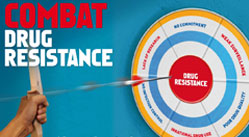|
Update on the cholera situation in Somalia, September 2016 |
 |
 |
- As of September 2016, a cumulative number of 13 598 acute watery diarrhoea/cholera cases and 497 (case–fatality rate 3.64%) deaths have been reported in 25 districts. Of these, 6452 (47.5%) were women and 7 884 (57.9%) were children under 5 years of age.
- As shown in the EPI curve, there was a 56% reduction in the number of cases reported, from 380 cases to 164 cases and zero deaths in September 2016.
- Only 27 cases of acute watery diarrhoea/cholera were reported during week 38–19 cases from the Banadir region, 8 from Beletweyne district. There were no acute watery diarrhoea/cholera cases reported in other places.
- Of the 10 stool samples collected from Banadir hospital in September, all of them tested negative forVibrio cholerae.
- Since January 2016, the most a�ected areas have been Mogadishu, Kismayo, Sakow, Bu'ale, Jowhar, Belethawo and Jalalaqsi.
Read the latest update on the cholera situation in Somalia, September 2016 |
|
Update on the cholera situation in Yemen, 30 October 2016 |
 |
 |
|
The Ministry of Public Health and Population in Yemen has released new figures on the number of cholera and cholera-related deaths in the country.
As of 30 October 2016, a total of 1410 suspected cases of cholera, including 45 associated deaths have been reported. Laboratory-confirmed cases of cholera have been reported from Taiz, Aden, Lahj, Al-Hudaydah, Hajjah, Sana'a, Al-Baida and and Ibb governorates. Of the 116 stools samples tested so far, 55 were positive for Vibrio cholerae 01 Ogawa at the Central Public Health Laboratory of Sana’a.
WHO is working in coordination with the Ministry and partners on the ground under a joint health/WASH taskforce to coordinate the response. WHO has established 21 cholera treatment centres in the most affected governorates, and provided IV fluids, diarrhoeal disease kits and oral rehydration solutions for case management in these centres. WHO also conducted a training workshop for epidemiological surveillance coordinators from 16 out of Yemen's 23 governorates to strengthen cholera case detection, reporting and response.
While acute watery diarrhoeal diseases are endemic in Yemen, the ongoing conflict has exacerbated the situation. More than 7.6 million people are currently living in areas affected by the outbreak, as well as more than 3 million internally displaced persons.
WHO has issued an appeal for funds on behalf of Yemen Health and WASH Clusters to scale-up priority response activities, and has released approximately US$ 1 million from its internal emergency funds to support the ongoing response efforts.
Related link
WHO releases emergency funds to support cholera response in Yemen, 27 October 2016 |
|
|
Cholera update in Yemen, 23 October 2016 |
 |
 |
|
23 October 2016 – The Ministry of Public Health and Population in Yemen has confirmed additional cases of cholera and cholera-related deaths in the country.
As of today, a total of 644 suspected cases of cholera, including 3 deaths, have been reported. 31 cases have been laboratory-confirmed so far. Among the deaths, 2 occurred in Sanaa and 1 death occurred in Aden governorate.
Acute watery diarrhoeal diseases are endemic in Yemen. It is the second most common cause of death, especially among infants and school children. As a result of the ongoing conflict, two third of Yemenis do not have access to clean water and sanitation services are limited, especially in cities, further increasing the risk of catching cholera.
WHO is working in coordination with the Ministry of Public Health and Population and partners on the ground to run a joint health/WASH taskforce to coordinate the daily response. WHO is also supporting the Ministry to take necessary public health measures to stop transmission and prevent the spread of cholera to other areas, enhance surveillance, improve case management and raise community awareness in high-risk areas.
Related link
Cholera outbreak – WHO and partners urgently require US$ 22.35 million to save lives and reduce suffering in Yemen, 18 October 2016 |
|
Cholera update in Yemen, 6 November 2016 |
 |
 |
|
The Ministry of Public Health and Population has published updated figures for cholera cases in the country.
A total of 2733 suspected cases and 51 associated deaths have been reported in Ta’iz, Aden, Lahij, Al Hudaydah, Hajjah, Sana'a, Al Bayda, Dhamar and Ibb. 75 cholera cases have been laboratory-confirmed so far.
While acute watery diarrhoeal diseases are endemic in Yemen, the ongoing conflict has stretched the capacity of the national health systems. More than 7.6 million people are currently living in areas affected by the outbreak, as well as more than 3 million internally displaced persons.
WHO is working in coordination with Ministry of Public Health and Population, UNICEF and partner nongovernmental organizations on the ground to run a joint Health and WASH taskforce to provide an integrated response.
This includes support for eDEWs/surveillance, laboratory support, establishment of 21 cholera treatment centres in affected governorates, training on early detection and management of cases, provision of essential supplies such as IV fluids, diarrhoeal disease kits, oral rehydration solutions and water chlorination kits.
WHO is also supporting social mobilization and health education among citizens to raise their awareness of cholera and diarrhoeal diseases.
Related link
Latest updates |
|
